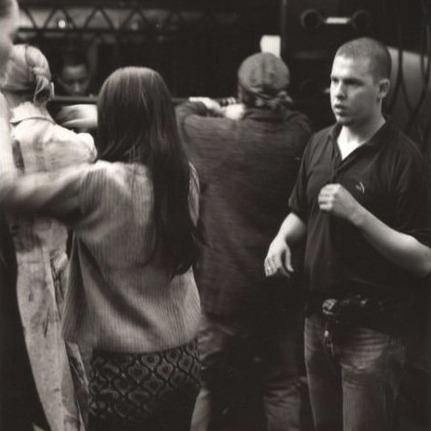For his A/W1994 collection (see it in full here),
McQueen decided to look to the ocean for inspiration. Citing Irish folklore, he
described the title of his Banshee collection
as a reference to the wailing song that banshees would sing, and this reference
was particularly evident in the uncharacteristically ethereal opening looks.
The show’s soundtrack began with a wailing song as models walked the runway in
floor-length gowns of organza, with layers that mimicked the waves of the ocean.
Fishnet dresses draped over models that looked like mermaids captured by
fishermen, and the small ruffled edges of one gown looked like tiny sea anemones.
Even the first three minutes weren’t short of controversy – a pregnant skinhead
in a beautiful black gown walked the runway, ‘MCQUEEN’ emblazoned upon her
shaven head, a look which was a nod back to his signature contrast of beauty
and aggression.
 |
| Montage, McQueen A/W1994 |
Then, the mood started
to change. The wailing song was replaced by a thumping techno beat and the
first flashes of crimson marked a shift towards provocation. The first clue
came in the lyrics of the soundtrack (“You
wanna fuck? Let’s go!”), and it soon became apparent that these banshees
were feeling horny. Models walked the runway with a seductive smile, winking
cheekily at the fashion press as they hitched up their skirts to reveal the PVC
undergarments that lay beneath. Shaggy knitwear was fitted with sheer panels
that left nipples exposed and even tailored suits were worn with sheer lace
tops underneath, or (in one case) a tight rubber bodice that left little to the
imagination. It wasn’t just the women that were there to shock either – one sole
male model walked the runway clutching his crotch as his bumsters threatened to
expose him entirely.
Long-term
collaborator, supporter and friend Isabella Blow was also present on the runway,
showing that you don’t need a ‘model figure’ to look great in McQueen’s
clothes. It was heartening to see the legendary journalist receive applause from
the crowd as she took the runway looking fabulous in a black chiffon dress with
a cream embellished waistcoat; in a sense, she is the woman that best embodies
the spirit of rebellion present in McQueen’s clothes. There was also a spin on
the traditional sailor’s uniform – nautical references came in the shape of
navy suits with gold buttons, teamed with blood-red chiffon shirts and
high-heeled black boots.
 |
| McQueen, backstage at the show |
The collection also
showcased McQueen’s ability to work with a range of fabrics – one particularly
interesting example was a gold holographic material, emblazoned with oversized florals.
The collection also included several variations of knitwear, a mesh dress
printed with an intricate floral pattern as well as a few evening coats that
appeared to be made from some kind of battered, paint-splashed canvas – the material
also made its way onto a few cut-out dresses (which, once again, exposed the
buttocks) which provided some of the highlights of the collection.
With this collection,
McQueen did what he needed to. He showed versatility by incorporating a few
more ethereal looks into the show, and he also reiterated the fact that he is
able to take a concept and convey it visually. In addition, he proved that he
is more than just shock tactics, one of the most frequent criticisms levelled
at him in the early stages of his career. Despite the pregnant skinhead, the
exposed flesh and the practically-exposed male model, the real focus of the
collection was the clothing – the experimentation with different materials, the
unusual take on silhouette and the flawless tailoring were all enough to garner
mainstream attention and keep the fashion press interested. However, the punk
blood still ran through the veins of the collection – the one element that sets
aside McQueen from his contemporaries.

No comments:
Post a Comment